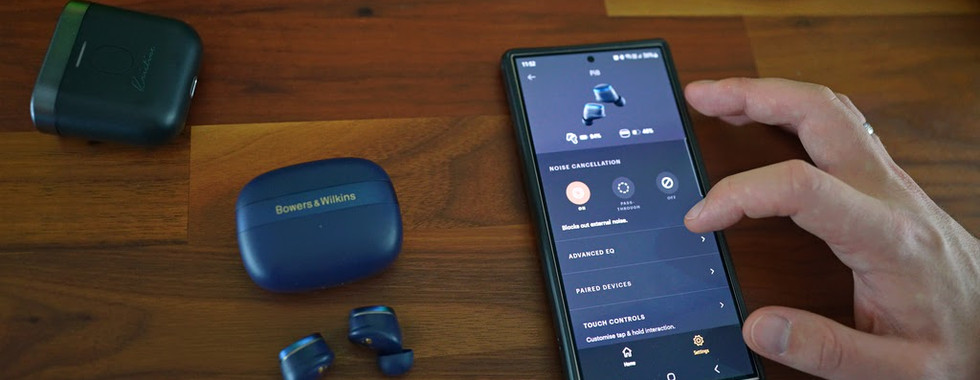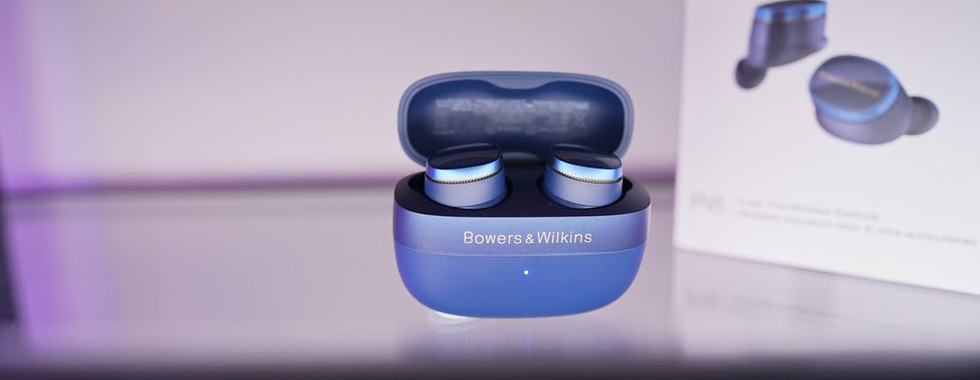Affiliate disclosure: as an Amazon Associate, we may earn commissions from qualifying purchases from Amazon.
In today’s review, we’re comparing the Bowers & Wilkins Pi8 to the previous generation Pi7 S2, and I would say the design changes alone are worth talking about. The Pi8 has a more streamlined shape that feels better in the ear, making it comfortable for extended wear. The new 12mm drivers bring improved sound quality, with clearer highs and more balanced mids compared to the Pi7 S2. The case itself has gone through a complete revamp and shrunk in size, making it more practical and pocket-friendly while still functioning as a wireless audio re-transmitter. Even the microphones have been repositioned for better call clarity, solving some issues from the previous model.
With the new colours, improved battery life, and four ear tip sizes for a better fit the Pi8 feels like a thoughtful evolution. Plus, with multi-point connection and a customizable EQ, this model adds versatility that its predecessor lacked.
But can all these changes really set the Pi8 apart from the Pi7 S2, especially in terms of sound? Stay tuned as we dive deeper!
While the Pi8 offers a premium set of features, there are still some minor frustrations. First thing that I noticed was the reset function on the case – it requires a pin, which feels unnecessarily cumbersome as compared to the last gen. A single, normal-sized button for this was more practical. That said, I am glad they kept the wireless charging, it’s particularly useful when I want to charge the earbuds by simply placing them on my phone or a wireless charging pad.
Right out of the box, the Pi8 feels great in the ear. They sit nicely and don't apply too much pressure; I could easily use them throughout the day and not feel bothered about any type of major discomfort. However, while they are a clear improvement over the Pi7 S2, they still don’t quite reach the comfort level of my Samsung’s earbuds. Sometimes they feel like they’re not quite fully secure, which can be a minor annoyance for picky users like me. Swapping out the ear tips for one of the included sizes might solve this for most users, but it’s something to keep in mind.
While testing the Pi8’s touch controls for ANC, voice assistant, and volume, I couldn’t help but wish for more customization options. Personally, I rarely use the voice assistant, so being able to remap that control specifically would be a welcome feature. On the plus side, the touch sensitivity is excellent, it doesn’t get triggered accidentally when adjusting them in the ear, which is a problem with some other earbuds. In part, this is due to their size – they are still pretty big.
When I used them for calls, the overall quality leaves room for improvement, particularly in noisy environments. It works well enough for casual calls, but for a product in this price range, I expected a bit more polish. The clarity just doesn’t match the premium sound experience you get when listening to music. For something that excels in other areas, the call performance feels a little underwhelming and could benefit from some fine-tuning, especially considering the competition at this level.
On the other hand, the overall sound quality is much better. You can really focus on a particular instrument or vocal, and the separation is noticeably superior to the Pi7 S2. The treble is much more defined, and the sound is cleaner, giving the music a dynamic, immersive quality.
When it comes to connection quality, the Pi8 has its highs and lows. In ideal conditions, the Bluetooth 5.4 and aptX Lossless features keep things smooth, but I did notice some occasional drop-offs when walking around with my phone in my pocket. It’s not a deal-breaker, but it’s something to be aware of, especially if you’re moving around frequently.
Battery life on the Pi8 is definitely a standout feature. During testing, after five hours of continuous use, there was still 25% battery left, which is quite impressive. Despite the smaller size of the case, it doesn’t compromise on power, offering an additional 20 hours of charge. And as I mentioned before - the case also supports wireless charging, so you can easily top them up without hunting for cables.
The active noise reduction is not the best but certainly good enough. I’ve been using them going around town, in the trains and buses and did not need to ever turn up the volume to counter any external sound.
The app, however, is one area that feels underwhelming. It’s functional for basic EQ and controls. To be honest I would like to have some sort of presets like Creative provides with their headphones. Besides EQ it also has True Sound feature, which essentially disables the EQ and plays sound in a most natural mode possible. This is handy if you have special preset for specific style of music or even movies and then change it back to “clean” mode as a toggle.
So in general, the Pi8 in comparison to Pi7 S2 is not just a generational improvement but rather evolution to something greater. It has much better sound with wider sound stage and feels more balanced. For those who want more bass, you can easily just adjust EQ to fit your preferences. I really can’t fault the sound from these headphones. The comfort when using them long term is also much improved, so much so that I think they might actually become my daily drivers.
There are a few areas where the Pi8 could be improved. The app could use a bit more refinement, call quality still needs work, and the touch controls would benefit from greater customization options. Plus, the premium price is something to consider. However, when it comes to delivering superior sound quality with excellent detail and balance, the Pi8 absolutely shines. What’s your take on them? Do they hit the mark for you? Share your thoughts in the comments below!
























































Comments